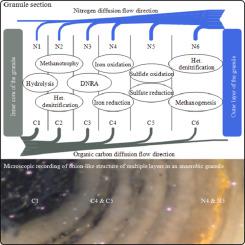Water Research ( IF 11.4 ) Pub Date : 2021-12-04 , DOI: 10.1016/j.watres.2021.117933 Bojan Pelivano 1 , Samuel Bryson 2 , Kristopher A Hunt 2 , Martin Denecke 3 , David A Stahl 2 , Mari Winkler 2

|
Granules recovered from a highly reduced anaerobic digester were capable of active nitrogen removal in the absence of exogenous electron donors, averaging 0.25 mg mgNO3−-N /gVSS/d over 546 days of operation. Electron mass balance indicated that about half the influent nitrate was converted to ammonia via DNRA and another half denitrified. This capacity was associated with an onion-like structure of multiple layers enriched in reduced iron and sulfur, and a complex microbial community shown by metagenomic sequencing to consist of multiple physiological groups and associated activities, including methanogenesis, denitrification, dissimilatory nitrate reduction to ammonia (DNRA), iron oxidation and reduction, and sulfur reduction and oxidation. Nitrate reduction was supported by both entrained organic material and reduced iron and sulfur species, corresponding to 2.13 mg COD/gVSS/d. Batch incubations showed that approximately 15% of denitrified nitrate was coupled to the oxidation of sulfur derived from both sulfate respiration and granular material enriched in iron-sulfide. Inhibition of sulfate reduction resulted in redirection of electron flow to methanogenesis and, in combination with other batch tests, showed that these granules supported a complex microbial community in which cryptic redox cycles linked carbon, sulfur, and iron oxidation with nitrate, sulfate, iron, and carbon dioxide reduction. This system shows promise for treatment of nitrate contaminated ground water without addition of an external organic carbon source as well as wastewater treatment in combination with (granular) sludge elimination leading in a net reduction of solid treatment costs.
中文翻译:

黄铁矿污泥与厌氧颗粒联合体在低碳系统中去除硝酸盐的应用
从高度还原的厌氧消化器回收的颗粒能够在没有外源电子供体的情况下主动脱氮,在 546 天的运行中平均为 0.25 mg mgNO 3 - -N /gVSS/d。电子质量平衡表明,大约一半的进水硝酸盐通过 DNRA 转化为氨,另一半则反硝化。这种能力与富含还原铁和硫的多层洋葱状结构以及宏基因组测序显示的复杂微生物群落相关,该微生物群落由多个生理群体和相关活动组成,包括产甲烷、反硝化、异化硝酸盐还原为氨。 DNRA)、铁的氧化和还原、硫的还原和氧化。硝酸盐还原得到夹带的有机物质以及还原的铁和硫物质的支持,相当于 2.13 mg COD/gVSS/d。批量培养表明,大约 15% 的反硝化硝酸盐与源自硫酸盐呼吸和富含硫化铁的颗粒材料的硫的氧化耦合。抑制硫酸盐还原导致电子流重定向至产甲烷作用,并与其他批次测试相结合,表明这些颗粒支持复杂的微生物群落,其中神秘的氧化还原循环将碳、硫和铁的氧化与硝酸盐、硫酸盐、铁、和二氧化碳减少。该系统显示出在不添加外部有机碳源的情况下处理硝酸盐污染的地下水以及废水处理与(颗粒)污泥消除相结合的前景,从而导致固体处理成本的净降低。











































 京公网安备 11010802027423号
京公网安备 11010802027423号